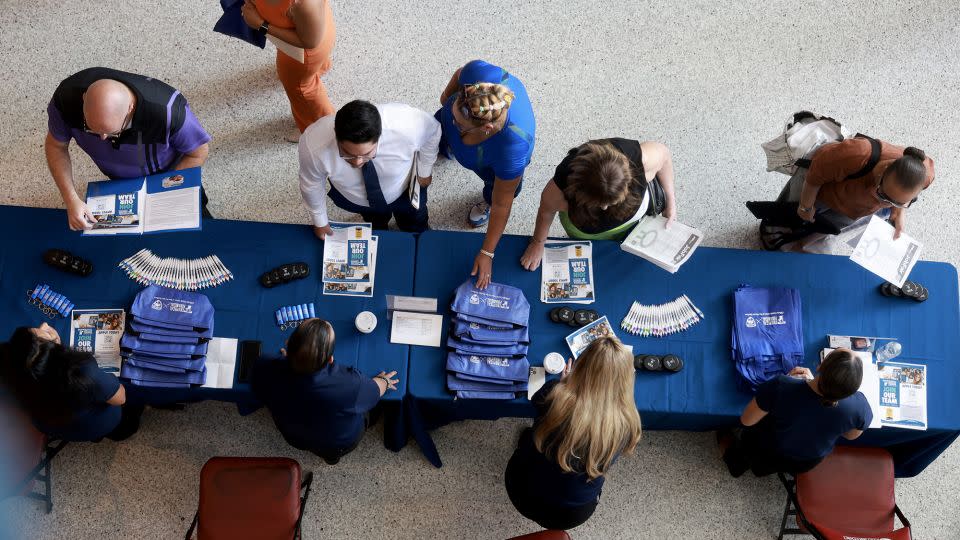Key takeaways from the June jobs report

Welcome to the “steady-as-she-goes” US labor market: Halfway through 2024, job gains are cooling slightly but overall employment activity remains solidly stable.
The US economy added 206,000 jobs in June, the Bureau of Labor Statistics reported Friday, easing from a downwardly revised May tally of 215,000 jobs.
The unemployment rate moved a little higher, up 0.1 percentage points to 4.1%, marking the first time since November 2021 that the jobless rate was above 4%.
That’s not too shabby at a time when interest rates are at a 23-year high and the Federal Reserve is looking for inflation and overall demand to cool before bringing down rates, said Gus Faucher, chief economist for the PNC Financial Services Group.
“We’re seeing job growth slow a bit; we’ve seen the unemployment rate tick up a little bit; we’ve seen wage growth slow a bit,” Faucher told CNN in an interview. “But those are all good news from the Fed’s perspective, should help reduce inflationary pressures coming from the labor market, and should support Fed rate cuts toward the end of this year.”
Economists were expecting employers to have added 190,000 jobs last month and for the unemployment rate to remain at 4%, according to FactSet consensus estimates.
Here are some of key points from the latest employment snapshot:
Government and health care again led the way
June’s job gains were more broadly based than they have been in the past few months, but the growth was largely concentrated in two sectors: government and health care.
The largest chunk of job gains occurred in the public sector, which added a net 70,000 jobs, specifically local government excluding education (up 34,100).
The health care industry added another 48,600 positions.
“This is another proof point for a steady-as-she-goes labor market where demand is shifting in some key sectors and employers and employees are staying put,” Ger Doyle, ManpowerGroup’s senior vice president, said in a statement issued Friday.
Some of the largest job losses occurred in temporary help services, which were down 48,900 for the month, dragging down the professional and business services super sector, which lost 17,000. Manufacturing and retail also saw losses, of 8,000 and 8,500, respectively.
The temporary help category is often closely watched by economists as it could serve as a forward-looking economic data point in an otherwise lagging indicator: If companies are growing, they’ll often get temporary help until they can hire for a full-time position; but if times are tougher, the temp workers usually are the first to go.
“The sharp decline in temporary help may portend future weakness in the labor market this summer,” Jack McIntyre, portfolio manager at Brandywine Global, wrote in commentary issued Friday.
Potential inflationary pressure slowed
Wage growth cooled as anticipated, with average hourly earnings rising 0.3% for the month and slowing to 3.9% on an annual basis, its lowest rate in three years.
Slowing wages help set the stage for the Federal Reserve to begin cutting interest rates — if it also ends up translating into slower inflation. Strong wage growth can put upward pressure on prices, but Fed officials have said they focus primarily on inflation gauges to know if price hikes are under control or not.
It’s possible for workers to rake in robust wage gains if productivity is keeping up, but last year’s productivity burst lost some steam in early 2024.
The labor force participation rate inched up to 62.6% from 62.5% after retreating by 0.2 percentage points in May.
Through the first half of the year, the US has added 1.3 million jobs at an average pace of 222,000 per month, BLS data shows. April and May’s job gains were both revised lower by a combined 111,000 jobs to 108,000 for April (down 57,000) and 218,000 for May (down 54,000).
Hiring activity is milder than this point last year — and job growth has retreated from the blockbuster pace of 2021 and 2022, during the pandemic recovery.
However, the labor market remains historically strong. The US just notched its 42nd consecutive month of job growth, the fifth-longest employment expansion on record.
Unemployment rate increased for the third month in a row
Much of the recent employment expansion has been marked by historically low unemployment: 30 months’ worth at or below 4%. However, that streak broke in June, when the jobless rate moved higher to 4.1%.
It’s the third month in a row that the unemployment rate increased.
That’s notable but not necessarily worrisome just yet, Faucher said.
“If we look at the last Fed dot plot, the median unemployment rate is 4.2% for the long run; we’re right around that,” Faucher said, referencing the central bank’s latest economic projections. “So, this means that we’re at the Fed’s definition of maximum employment; it means that wage pressures are less pronounced coming from the labor market; and it’s a good, solid labor market that is consistent with low inflation and solid long-run economic growth.”
Still, Friday’s report did appear to confirm what other recent employment data has been showing: Job opportunities have shrank (but still are well above pre-pandemic levels), and people are staying unemployed for longer.
The median duration of unemployment jumped higher, to 9.8 weeks from 8.9 weeks in May and landed at a level not seen since January 2023, BLS data shows.
But what happens if the unemployment rate keeps moving higher?
“Now, if we start to get closer to 4.5%, am I going to be a little more concerned? Yes. But I think we have the kind of labor market that we want to see over the longer run.”
CNN’s Bryan Mena contributed to this report.
For more CNN news and newsletters create an account at CNN.com

 Yahoo Finance
Yahoo Finance 